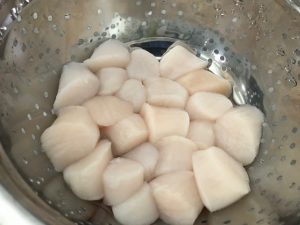I made my first scallop order from New England Fishmongers several months ago at the start of the scallop season. It was a bit of an experiment. My spouse scoffed a little.. “they’re expensive… I’m not sure I like them..,” but I persevered. I remembered this same conversation about our fish share last summer and by June “Fish Night Tuesday” was our favorite dinner of the week and a certain someone became a local fish connoisseur. After a delicious chili-lime scallop dish earlier this week (see below!), someone was quickly changing his tune and wondering whether we could order more scallops. He’ll learn! Scallop season in New England is quickly coming to a close, but I was able to sneak in one last order from New England Fishmongers, who have been busily harvesting and delivering native scallops for the last several months. The season starts around holiday time and is looking to wrap up in the next week or so.
And, just to be fair… my spouse is an excellent cook who has taught me a thing or two in the kitchen as well. Something is always on the stove in our house and we like to believe it’s the focal point for a loving exchange of ideas, and recipes.
Bay/Sea, Dry/Wet… What’s it all about?
New England Fishmongers harvests day-boat sea scallops. This means that the scallops were harvested relatively close to shore from a small fishing vessel. Sea scallops, as the name suggests, are harvested in open sea waters and not in closed bays. They are typically categorized by size or how many scallops/”units” fit in a pound. Bay scallops tend to be smaller in size. Scallops coming from the New England Fishmongers are what are referred to as “dry scallops,” meaning that they were
not soaked or treated with a solution meant to extend their shelf-life — they are untreated and fresh off the boat!
A Little Science

Scallops are bivalve mollusks. This means that they are a soft-bodied invertebrate with a two-part hinged shell and breathe/filter feed through gills. When we eat scallops, weare eating what is known as the adductor muscle, which is responsible for opening and closing the shell. The “foot” a hard tendon that we remove from the scallop, is responsible for rooting and moving the scallop in the water. When we receive a pile of white flesh, we are receiving scallops that have been shelled.
I Ordered Scallops… Now What?
At nearly $20/lb, local scallops are certainly a delicacy in our house. The upside is that they can be enjoyed long past the harvest season because they freeze extremely well. When you receive your scallops, follow these simple steps as soon as possible:

- Rinse the scallops in a colander with cold water. Gently agitate them with your hand.
- Remove the hard tendon, sometimes referred to as the ‘foot.” Some sources suggest a paring knife. I find that it is easiest and best to gently peel this off with your fingers, working carefully not to rip the delicate flesh of the scallop.
- Pat each scallop dry and place on a lightly oiled parchment-lined cookie sheet or plate. This sounds tedious, but goes quickly. 1lb fits nicely on a serving plate. 2lbs fit perfectly on a full size cookie sheet
- Place uncovered in freezer until completely frozen, then place in appropriately sized freezer bags or containers, removing as much oxygen as possible.
Tip: I freeze in 1lb packages, which seems about right for a two-person dinner.
Ok, They’re Frozen… How do I eat them?
A day before, remove the scallops from the freezer and into the fridge. The day you plan to cook them, remove them from their package and rinse them in cold water. Feel them to make sure they are thawed through. Dry them off before cooking, but they are ready to cook with at this point.
There are hundreds of scallop recipes out there. Dumplings, risottos, stews and soups… but our favorite is to sear the scallops in a hot pan (cast iron or non-stick works) and serve with a flavored sauce and sides. Scallops have a very mild flavor, so the sauce pairings are endless from a simple brown butter sauce to asian-inspired twists. Most recently, we cooked a NYT Cooking Recipe: Seared Sea Scallops with Ginger Lime Butter.
- 3 tablespoons unsalted butter, at room temperature
- 1 tablespoon grated peeled ginger
- 1 fresh hot red chile pepper, finely chopped (I used red pepper flakes instead)
- Zest and juice of 1 lime
Directions:
- Melt the butter in a small dish and add other ingredients to taste
- Heat a pan with a coating of olive oil on medium-high heat
- Dry the scallops then sprinkle with salt and pepper.
- When the pan is hot, add the scallops. Do not disturb, but flip when the bottoms have a nice sear (~4m)
- Sear the remaining side, being careful not to over cook (~2-3m) and remove from pan to warm plates.
- Re-melt the butter mixture if needed and pour over scallops
We served this with a fresh salad and roasted sweet potatoes, using the butter sauce as a dressing for the salad as well.

